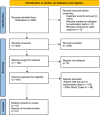Evaluating the effects of air disinfectants in decontamination of COVID-19 aerosols
- PMID: 36644313
- PMCID: PMC9831143
- DOI: 10.1002/hsr2.1042
Evaluating the effects of air disinfectants in decontamination of COVID-19 aerosols
Retraction in
-
Retraction statement: Evaluating the effects of air disinfectants in decontamination of COVID-19 aerosols.Health Sci Rep. 2023 Jul 25;6(7):e1461. doi: 10.1002/hsr2.1461. eCollection 2023 Jul. Health Sci Rep. 2023. PMID: 37502118 Free PMC article.
Abstract
Introduction: Airborne transmission is the most crucial mode of COVID-19 transmission. Therefore, disinfecting the severe acute respiratory syndrome coronavirus-2 (SARS-CoV-2) aerosols float can have important implications in limiting COVID-19 transmission. Herein, we aimed to review the studies that utilized various disinfectants to decontaminate and inactivate the SARS-CoV-2 aerosols.
Methods: This study was a review that studied related articles published between December 1, 2019 and August 23, 2022. We searched the online databases of PubMed, Scopus, Web of Science, Cochrane, on August 23, 2021. The studies were downloaded into the EndNote software, duplicates were removed, and then the studies were screened based on the inclusion/exclusion criteria. The screening process involved two steps; first, the studies were screened based on their title and abstract and then their full texts. The included studies were used for the qualitative analysis.
Results: From 664 retrieved records, only 31 met the inclusion criteria and were included in the final qualitative analysis. Various materials like Ozone, H2O2, alcohol, and TiO2 and methods like heating and using Ultraviolet were described in these studies to disinfect places contaminated by COVID-19. It appeared that the efficacy of these disinfectants varies considerably depending on the situation, time, and ultimately their mode of application.
Conclusion: Following reliable protocols in combination with the proper selection of disinfectant agents for each purpose would serve to achieve desired elimination of the SARS-CoV-2 transmission.
Keywords: COVID‐19; SARS‐CoV‐2; aerosol; decontamination; disinfectants.
© 2023 The Authors. Health Science Reports published by Wiley Periodicals LLC.
Conflict of interest statement
The authors declare no conflict of interest.
Figures
Similar articles
-
Environmental disinfection against COVID-19 in different areas of health care facilities: a review.Rev Environ Health. 2020 Aug 26;36(2):193-198. doi: 10.1515/reveh-2020-0075. Print 2021 Jun 25. Rev Environ Health. 2020. PMID: 32845869 Review.
-
Evaluation of the impact of different disinfectants on new coronavirus and human health.Rev Environ Health. 2022 May 5;38(3):451-460. doi: 10.1515/reveh-2022-0051. Print 2023 Sep 26. Rev Environ Health. 2022. PMID: 35508445 Review.
-
Universal screening for SARS-CoV-2 infection: a rapid review.Cochrane Database Syst Rev. 2020 Sep 15;9(9):CD013718. doi: 10.1002/14651858.CD013718. Cochrane Database Syst Rev. 2020. PMID: 33502003 Free PMC article.
-
Portable HEPA Purifiers to Eliminate Airborne SARS-CoV-2: A Systematic Review.Otolaryngol Head Neck Surg. 2022 Apr;166(4):615-622. doi: 10.1177/01945998211022636. Epub 2021 Jun 8. Otolaryngol Head Neck Surg. 2022. PMID: 34098798
-
Interventions to reduce contaminated aerosols produced during dental procedures for preventing infectious diseases.Cochrane Database Syst Rev. 2020 Oct 12;10(10):CD013686. doi: 10.1002/14651858.CD013686.pub2. Cochrane Database Syst Rev. 2020. PMID: 33047816 Free PMC article.
Cited by
-
Retraction statement: Evaluating the effects of air disinfectants in decontamination of COVID-19 aerosols.Health Sci Rep. 2023 Jul 25;6(7):e1461. doi: 10.1002/hsr2.1461. eCollection 2023 Jul. Health Sci Rep. 2023. PMID: 37502118 Free PMC article.
References
-
- Mehraeen E, Salehi MA, Behnezhad F, Moghaddam HR, SeyedAlinaghi S. Transmission modes of COVID‐19: a systematic review. Infectious Disorders ‐ Drug Targets. 2021;21(6):e170721187995. - PubMed
-
- Karimi A, Nowroozi A, Alilou S, Amini E. Effects of androgen deprivation therapy on COVID‐19 in patients with. Urol J. 2021;18(6):577‐584. - PubMed
Publication types
LinkOut - more resources
Full Text Sources
Miscellaneous


